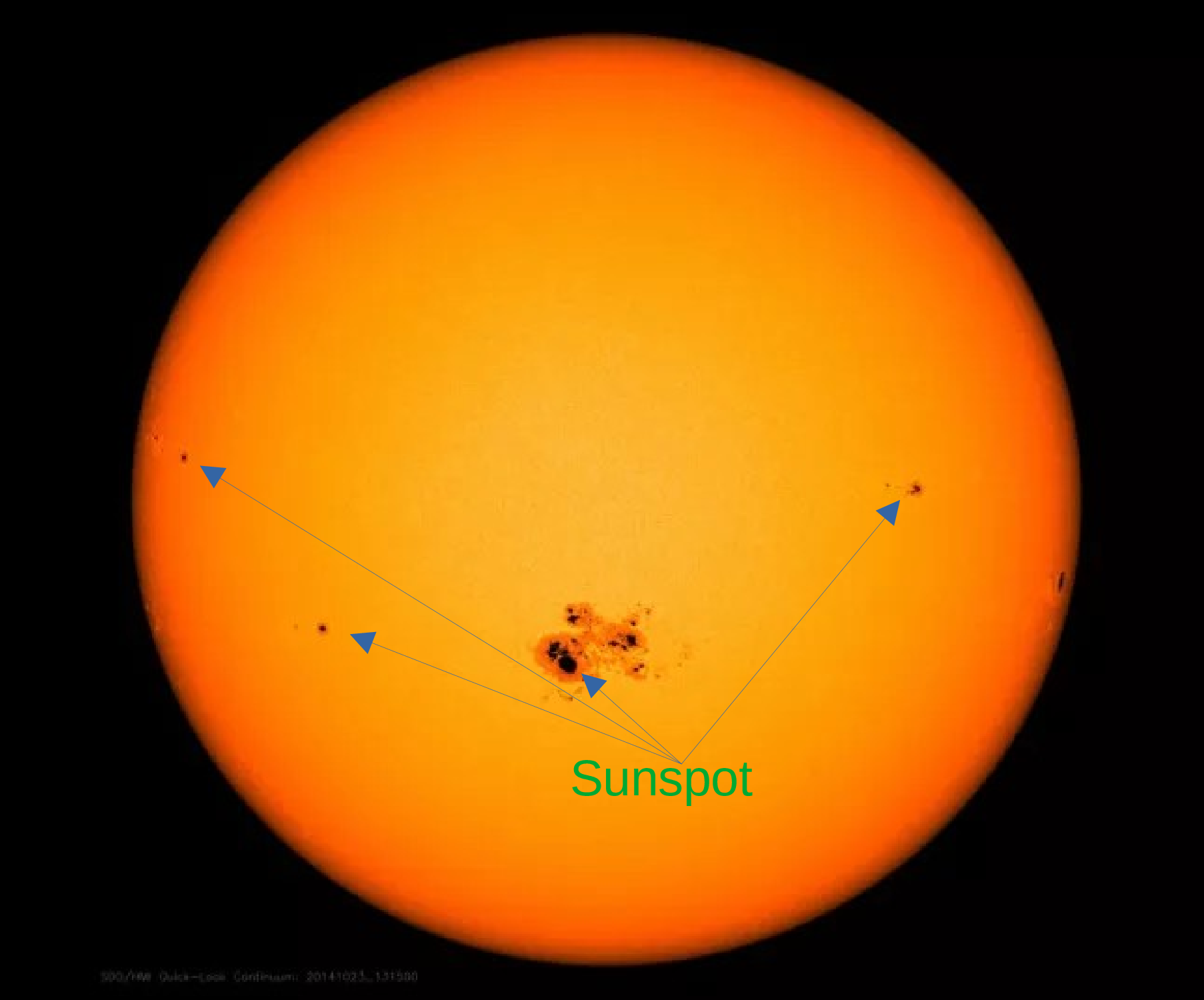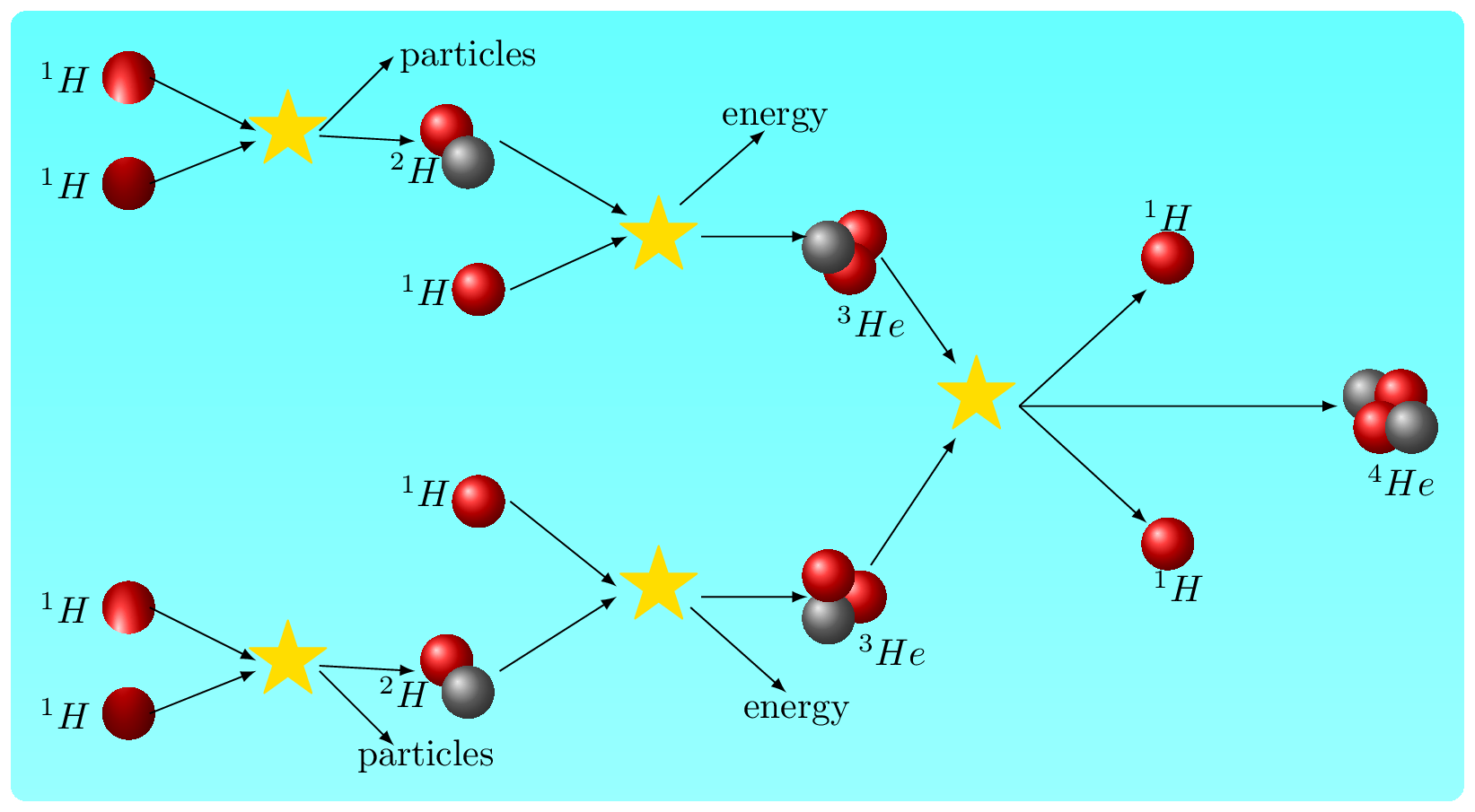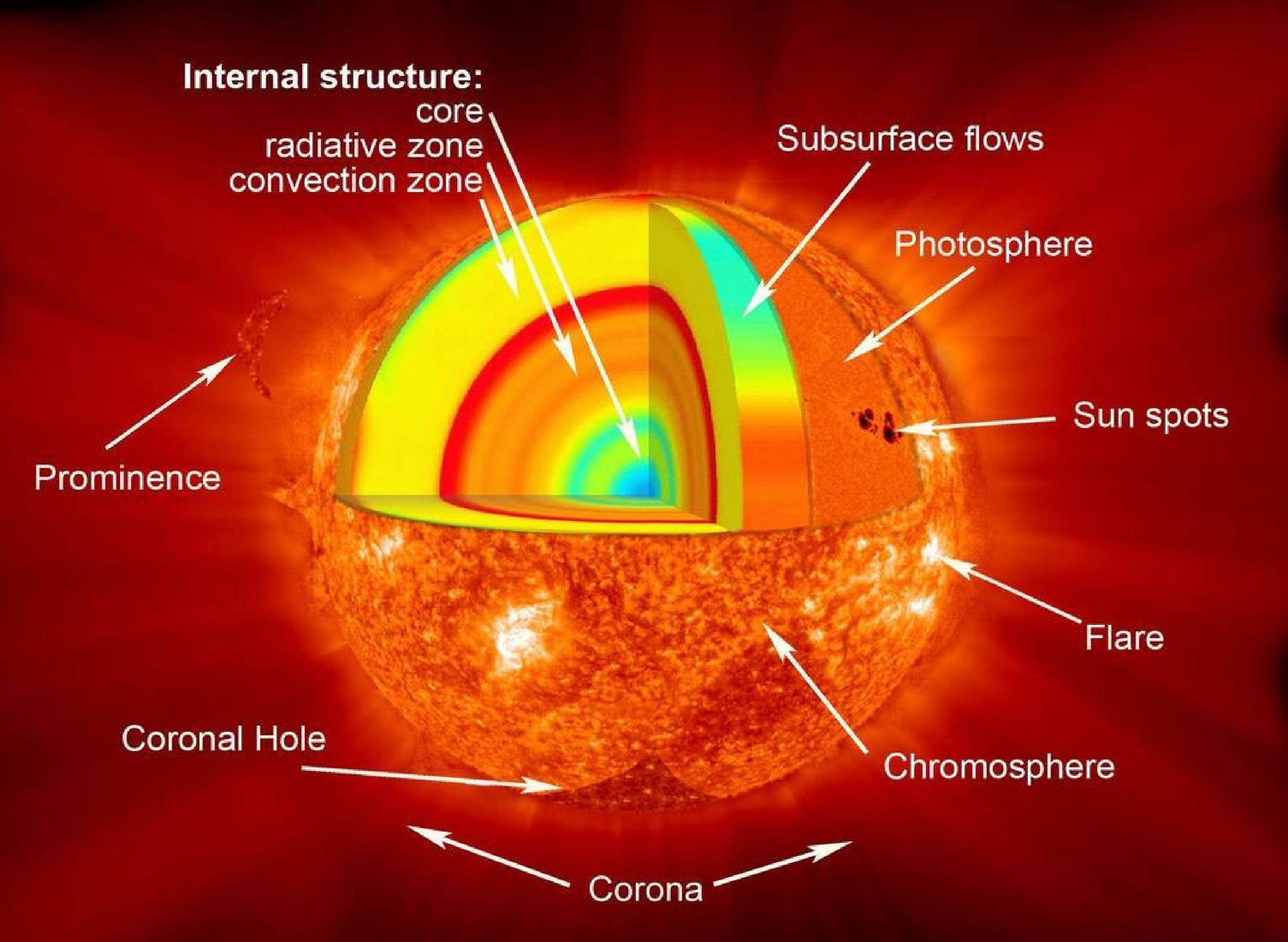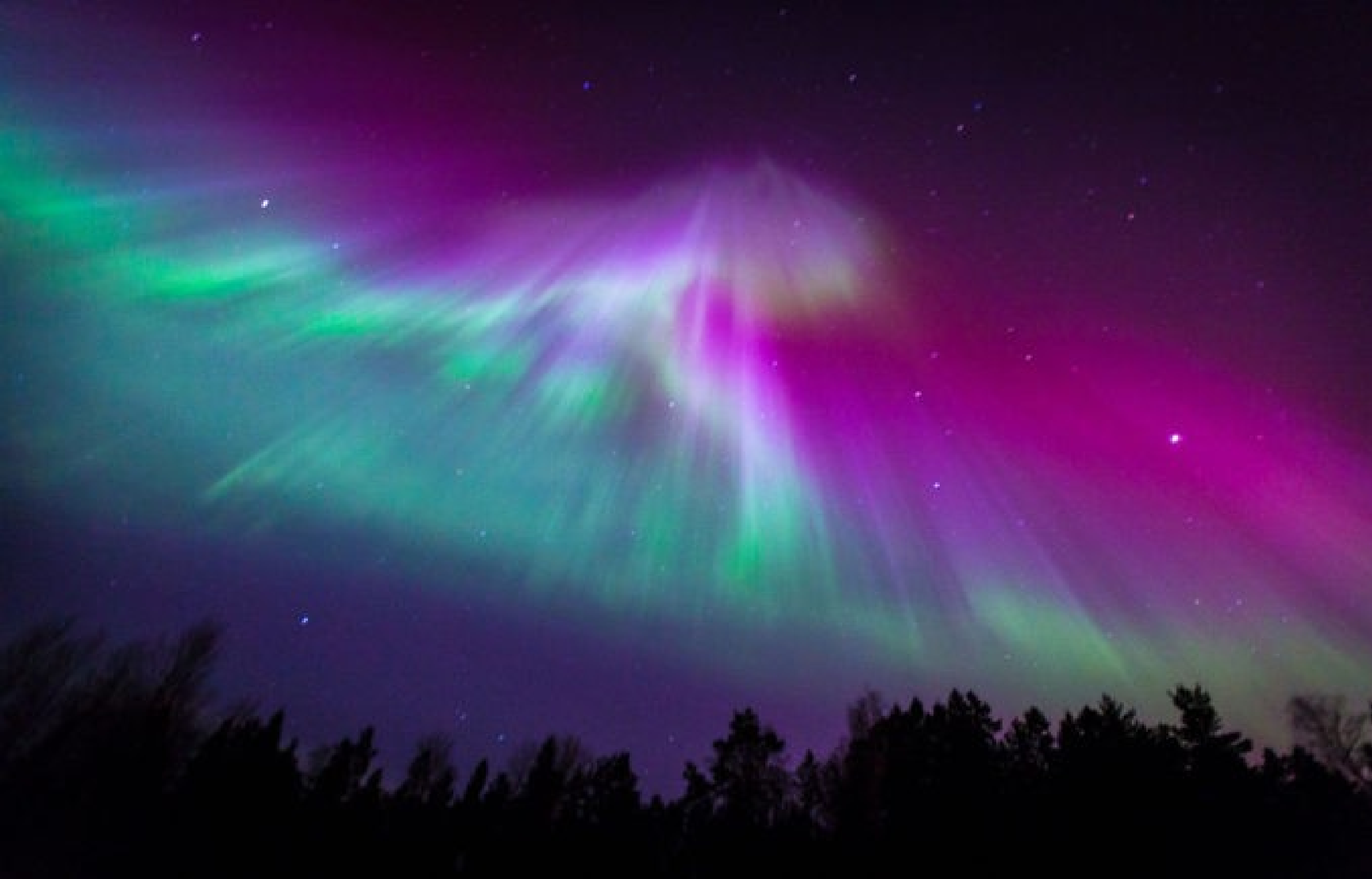Subsection 13.1.2 The Sun

2
www.space.com/sunspots-formation-discovery-observations

The Sun is a star located at the center of our solar system . It is a massive, glowing ball of gas born in the sky about 4.6 billion years ago. It is about 1.39 million kilometers in diameter and is mostly composed of hydrogen (about 74% of its mass) and helium (about 24% of its mass) with trace amounts of other elements. The Sun is classified as a G-type main-sequence star which is a relatively stable and has long-live. The Sun is in the continuous process of fusing hydrogen [Figure 13.1.2.(b)] into helium in its core. This fusion process releases a tremendous amount of energy in the form of light and heat, which makes the Sun shine. The Sun’s magnetic field is responsible for sunspots, [Figure 13.1.2.(a)] solar flares, and coronal mass ejections, which can have a significant impact on Earth’s climate and technology. The dark patch on the sun’s surface is known as sunspot. It is relatively cooler part of sun’s surface due to magnetic field lines. The Sun’s activity (the number of spots on the sun increases and decreases) follows an 11-year cycle, called the solar maximums and minimums.

3
www.nasa.gov/mission_pages/sunearth/science/Sunlayers.htmlThe Sun is composed of several distinct parts. Such as Core: The core is the central region of the Sun where nuclear fusion occurs. The temperature in the core is about 15 million degrees Celsius, and the pressure is about 250 billion times greater than the surface of the Earth. In the core, hydrogen atoms are fused together to form helium, releasing a tremendous amount of energy in the process. Radiative Zone: The radiative zone is the region of the Sun where energy is transported by photons (particles of light). The energy produced in the core travels outwards through the radiative zone over a period of about 100,000 years. Convective Zone: The convective zone is the outermost layer of the Sun’s interior. The convective zone is characterized by a boiling motion which is similar to water boiling in a pot. Photosphere: The photosphere is the visible surface of the Sun. This is from where most of the light and heat we receive on Earth originate. The temperature of the photosphere is about 5,500 degrees Celsius, and it appears as a bright, yellow disk in the sky. Chromosphere: The chromosphere is the thin layer of gas above the photosphere. It is visible during a total solar eclipse as a reddish-pink ring around the Sun. The temperature of the chromosphere is about 4,000 to 20,000 degrees Celsius. Corona: The corona is the outermost layer of the Sun’s atmosphere. It extends millions of kilometers into space and is visible during a total solar eclipse as a faint, white halo around the Sun. The temperature of the corona is several million degrees Celsius, much hotter than the surface of the Sun.
Sun’s atmosphere can be detected through its characteristic absorption lines in the Sun’s spectrum [Figure 13.1.2.(c)]. Elements are created through nuclear fusion processes as the Sun fuses hydrogen into helium, the byproducts of this process can go on to create heavier elements, which eventually settle into the Sun’s interior.
Subsubsection 13.1.2.1 Solar Energy
Solar energy is generated from the sun’s radiation through a process known as nuclear fusion [Figure 13.1.2.(b)]. The high temperature and pressure in the core of a star cause the atomic nuclei to collide and merge to create a heavier nucleus and release energy in the process. The energy produced by the fusion reactions [Subsection 7.2.2] The Nuclear Fusion Reaction in a star is carried by radiation in the form of photons, which slowly make their way outwards from the core of the star. This energy is what powers the star and allows it to shine brightly in the sky. As a star ages and begins to run out of hydrogen fuel in its core, it may begin to undergo other fusion reactions that involve heavier elements. These reactions can produce even more energy, but eventually the star will exhaust all of its nuclear fuel and will either become a white dwarf, neutron star, or black hole, depending on its mass.
4
astro.unl.edu/classaction/animations/sunsolarenergy/fusion01.htmlSubsubsection 13.1.2.2 Aurora Borealis

5
www.beautifulworld.com/europe/norway/aurora-borealis/Auroras, also known as the Northern or Southern Lights, are natural phenomena that occur in the Earth’s upper atmosphere when charged particles from the Sun interact with the Earth’s magnetic field. The Sun constantly releases a stream of charged particles, known as the solar wind, into space. When the solar wind encounters the Earth’s magnetic field, it can cause the field lines to become distorted and create a region of charged particles trapped in the Earth’s magnetosphere. Some of these particles, primarily electrons and protons, are funneled down towards the Earth’s polar regions by the Earth’s magnetic field. When these charged particles collide with the gases in the Earth’s upper atmosphere, such as nitrogen and oxygen, they can excite the atoms and molecules, causing them to emit light. This produces the colorful and shimmering displays of light known as auroras. Green color auroras are produced by excited oxygen atoms at lower altitude in the atmosphere, while red auroras are produced by excited oxygen molecules at higher altitudes. The pink or purple hues that sometimes appear in the aurora are caused by the collision of charged particles with nitrogen molecules in the Earth’s atmosphere. Note: The term aurora borealis specifically refers to the northern lights, which are visible in the northern hemisphere. The term aurora australis refers to the southern lights, which are visible in the southern hemisphere.
